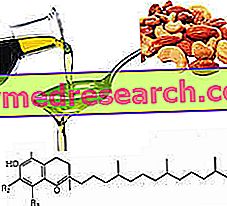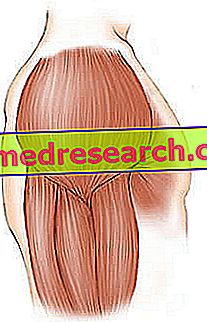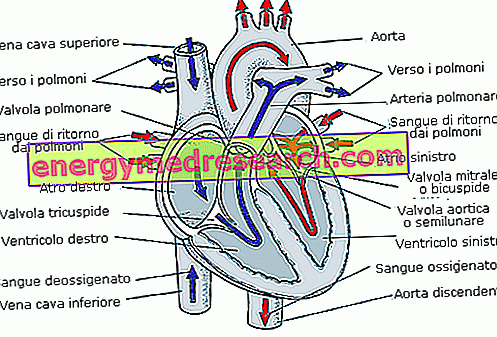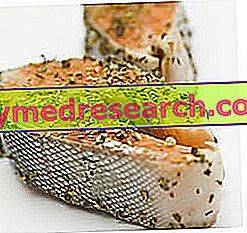Vitamin E or tocopherol prevents the oxidation reactions of polyunsaturated lipids and acts as a biological antioxidant.
In particular in the human body tocopherol is the main liposoluble antioxidant to exert a protective effect against oxidative stresses. In this sense it performs an action similar to that of vitamin C.
Chemical Structure

Tocopherol uptake
Tocopherol absorption occurs mainly in the medial part of the small intestine by passive diffusion.
Like all fat-soluble vitamins, the absorption of tocopherol also requires adequate emulsion and micellar solubilization. The esterified forms are probably hydrolyzed by an esterase of the duodenal mucosa and the alcohol form thus obtained is absorbed.
Tocopherol absorption can therefore occur only in the presence of bile salts and fats.
The absorption efficiency is low and variable (20 ÷ 60%) and decreases as the intake increases.
Once vitamin E is absorbed it passes into the lymphatic circulation associated with chylomicrons (45%); it then concentrates in the chylomicrons remnants that release it to the liver (the main organ of deposit). Within the hepatocytes it is incorporated into nascent VLDL (11%), from which it then passes to LDL (65%) and HDL (24%).
The transport of tocopherols by lipoproteins has several implications:
polyunsaturated fatty acids are protected from the attack of free radicals;
The plasma concentration of tocopherols depends not only on dietary intake but also varies according to the concentration of lipoproteins.
Tocopherol is also present in erythrocytes (red blood cells) where it is concentrated especially in the membranes (15 ÷ 25% of the plasma concentration).
Lipoproteins carry tocopherols to different tissues, including liver, lungs, heart, muscles and adipose tissue.
Vitamin transfer mechanisms from lipoproteins to tissues are thought to be the same as those used for lipid transfer.
Adipose tissue differs from other tissues by continuously taking tocopherols from the blood, it seems that in obese adipose tissue refers to tocopherols from other tissues. During intense exercise there is a significant increase in the circulating levels of tocopherol (10 ÷ 20%), probably due to mobilization from adipose tissue during lipolysis.
Once in the cells, tocopherols concentrate especially in structures that contain membrane phospholipids, such as mitochondria, microsomes and plasma membranes
Tocopherol functions
Tocopherol and diabetes
Vitamin E inhibits the oxidative stresses involved in aging, in the pathogenesis and in the complications of diabetes (cataracts and cardiovascular problems).
Tocopherol and coronary artery disease
Tocopherol can exert protective effects against coronary heart disease. According to the antioxidant hypothesis, the inhibition of LDL oxidation is the main mechanism by which vitamin E performs this protective action.
Tocopherol and cancer
Vitamers E can protect against carcinogenesis and tumor growth, through antioxidant properties and / or immunomodulatory functions: elimination of mutagens, superoxide radicals and / or nitrogen dioxide, inhibition of DNA and protein peroxidation, induction of apoptosis by inhibition of DNA synthesis in cancer cells.
Antioxidant activity in foods
Tocopherols and tocotrienols can be added to foods to stabilize polyunsaturated fatty acids.
The addition of tocopherols in the form of mixtures is an effective way to improve the oxidative stability of oils, because in mixtures, they protect and regenerate one another.
Often tocopherols and tocotrienols are added mixed with other compounds such as ascorbic acid or chelating agents that improve the effect of tocopherols as natural antioxidants.
Vitamin E in cosmetics with an anti-aging action - Tocopherol in cosmetics - Tocopherol Acetate in cosmetics
shortage
Situations of tocopherol deficiency in humans in normal conditions are very rare.
It is very difficult to induce a vitamin E deficiency in adults, both due to the diffusion in food and to the reserves in the body.
A primitive and spontaneous deficiency was observed only in premature infants, due to poor tissue reserves resulting from the modest trans-placental passage of tocopherol; the deficiency can also be a consequence of the use of artificial milk rich in PUFA (polyunsaturated fatty acids).
Tocopherol deficiency can lead to the appearance of a neurodegenerative syndrome that includes a peripheral neuropathy associated with necrotizing myopathy, cerebral ataxia with ophthalmoplegia and pigmented retinopathy.
Integration and toxicity of tocopherols
Because diets generally have an abundance of vitamin E, vitamin E deficiency is rare in humans and limited to malnourished people, patients with fat malabsorption and those with defects in hepatic tocopherol-binding protein.
However, certain groups of people at risk of oxidative stress (eg smokers, diabetic patients, athletes) are advised to take antioxidant supplements.
The tocopherols and tocotrienols used as supplements are obtained by extraction from natural sources or by chemical synthesis.
Natural and synthetic products act in a similar manner as potential antioxidants, but the former have vitamin E activity greater than the latter
EXTRACTION FROM NATURAL SOURCES
The main natural sources of tocopherols and tocotrienols are the distillates obtained from the processing of edible oil (soybean oil, corn, sunflower, rapeseed, palm). The use of rice bran, wheat fiber and other by-products is growing.
CHEMICAL SYNTHESIS
A racemic mixture of eight stereoisomers is formed. With new technologies, such as the use of strong solid catalysts, large quantities of product and high selectivity are obtained.
The purposes of a possible tocopherol supplementation are:
Vitaminization → makes foods that normally do not contain vitamins that carry vitamins.
Reconstruction → to compensate for the loss of vitamins during food treatment.
Fortification → to ensure adequate vitamins.
Standardization → the fortification of a product against a standard within its class.
TOXICITY
Tocopherols are poorly toxic compared to other fat-soluble vitamins.
Since vitamin E is used as a supplement to prevent pathological processes in which free radicals are involved, its safety in use has been tested and it has been seen that only in excess of 2, 000 mg / day in some individuals disorders occur mainly in the intestine.
At high doses, tocopherol can interfere with the activity of other liposoluble vitamins, probably limiting their absorption; we have seen that animals with hypervitaminosis have inadequate mineralization, reduced retinol (vitamin A) and coagulopathies, which regress after administration of calciferol, retinol and vitamin K.
Tocopherol-bringing foods
Tocopherols are contained mainly in foods of vegetable origin. The richest foods are: oils (wheat germ oil), some vegetables, cereal kernels and seeds in general.
In higher plants the total amount of tocopherols and tocotrienols is greatest in mature leaves and in other tissues exposed to light. Instead it is minimal in roots and tissues grown in low light.
In wheat, as in other cereals (barley, oats, corn, rice), tocopherols are concentrated in the germ, and tocotrienols in bran and endosperm.
The content of tocopherols and tocotrienols depends on the geographical and climatic conditions, the maturity of the seed during the harvest and the variety of the plant. Temperature is the most effective environmental factor in controlling the content of tocopherols and tocotrienols.
The content and composition of tocopherols and tocotrienols can be modified by traditional or modern plant reproduction techniques.
The refining processes of seed oils lead to sometimes considerable losses of vitamin.
Cooking causes a depletion of the vitamin content especially in frying and baking.
Conservation especially in the presence of polyunsaturated fatty acids leads to gradual losses of tocopherols, the lower the storage temperature, the lower the loss.
Food | Vitamin E [mg / 100g] |
| Oil, wheat germ | 133 |
| Oil, sunflower | 68 |
| Oil, corn | 34.5 |
| Oil, palm | 33.1 |
| Almonds, sweet, dried | 26. |
| Extra virgin olive oil | 22.4 |
| Oil, cod liver | 19.8 |
| Oil, peanut | 19.1 |
| Olive oil | 18.5 |
| Wheat germ | 16.0 |
| Hazelnuts, dried | 15.0 |
| Margarine, 1% vegetable | 12.4 |
| Avocado | 6.4 |
| Nuts, dried | 4. |
| Pistachios | 4. |
| Pecan nuts | 3. |
| Butter | 2.4 |
| wheat bran | 1.6 |
| Cashews | 1. |
| Oil, coconut | 0.9 |
| Eel, breeding, fillets | 0.82 |
| Rice, whole, raw | 0.7 |
| Pecorino cheese | 0.7 |
| Parmigiano | 0.68 |
| Fontina | 0.62 |
| Taleggio cheese | 0.62 |
| Grain | 00:55 |
| Gorgonzola | 00:52 |
| Provolone | 00:52 |
| Corn, sweet, canned, drained | 0.5 |
| Rice, parboiled, raw | 0.5 |
| Semolina | 0.5 |
| Tuscan Caciotta | 00:49 |
| Scamorza | 00:48 |
| Growth | 00:45 |
| Caciocavallo | 00:43 |
| Flour, whole wheat | 0.4 |
| Mozzarella, of cow | 00:39 |
| Caciottina, vaccina | 00:34 |
| Mozzarella, buffalo | 00:24 |
| Caciottina, fresh | 00:22 |
| Ricotta, cow | 00:21 |
| Yogurt, dairy, whole | 00:08 |
| Milk, cow, pasteurized, whole | 00:07 |
| Milk, cow, UHT, whole | 00:07 |
| Yogurt, dairy, partially skimmed | 00:06 |
| Milk, cow, pasteurized, semi-skimmed | 00:04 |
| Milk, cow, UHT, partially skimmed | 00:04 |
Recommended ration
The needs of tocopherols are closely linked to the intake of other nutrients and in particular of PUFA (polyunsaturated fatty acids) and must therefore be defined in relation to them.
Consequently the minimum daily need was not established, but reference was made to the amount of PUFA, selenium and sulfur amino acids in the diet.
Therefore, in light of what has just been said, the LARN foresee that the recommended ration is equal to:
Equivalent tocopherol (mg) | ≥ 0.4 |
g PUFA (polyunsaturated fatty acids) |



